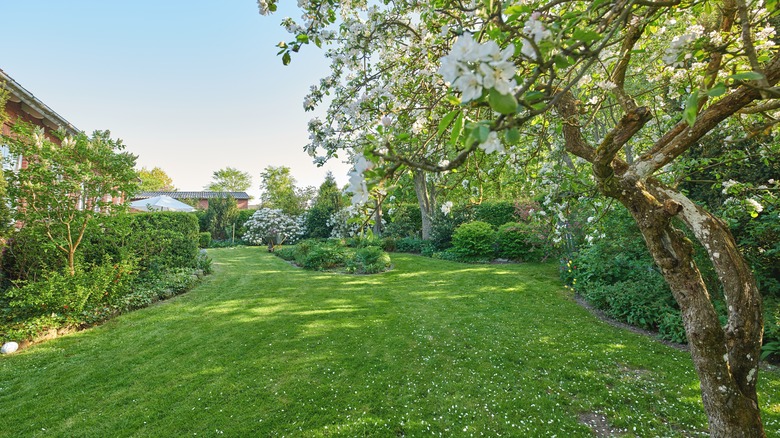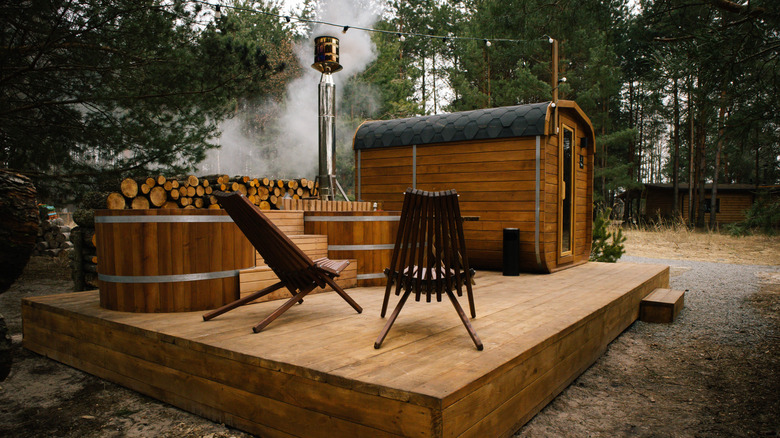The Backyard Feature That's Gaining Popularity And How To Add It To Your Own Yard
There are some backyard design choices that make it harder for you to sell your house, from high-maintenance swimming pools to way too much paving, which takes away valuable gardening real estate. There is, however, a trending garden design methodology that can be as easy to implement as you want it to be and is proven — yup, by scientific studies — to improve your mental and likely even your physiological health. Wellness gardens can consist of something as simple as plonking a yoga mat down in the middle of your lawn and hanging up a wind chime, though the more sweetly scented flowering shrubs, water features, walking paths, and cozy seating areas you add, the more your mind and body — and those of other household residents and even visitors — will benefit.
The popularity of wellness yards tracks with a seemingly insatiable fervor for general wellness in the first half of this decade. However, the concept is far from new — pioneering renditions, like Japanese Zen gardens, Medieval monastery gardens, and even the painter Claude Monet's oft-depicted garden, date back centuries. These health-focused green spaces, sometimes also referred to as therapeutic or healing gardens, have been winning awards and wowing visitors at flower shows in recent years, from the famed RHS Chelsea Flower Show in the U.K. to the Melbourne International Flower & Garden Show in Australia. A wellness garden by Bryn Mawr College took home a blue ribbon at the 2022 edition of the Philadelphia Flower Show. Private and government health support centers and educational institutes are integrating wellness yards into their grounds.
How to turn your backyard into a haven for wellbeing
Since everybody's concept of well is different, there are no hard and fast rules regarding wellness yard creation. But that doesn't mean there aren't guidelines to follow. Deciding whether you want to create a restorative (passively walking, sitting, and contemplating) or enabling (actively growing, moving, socializing) garden can help you decide what features might best suit. Alternatively, list your needs for a health-focused backyard in order of priority, encompassing accessibility and spatial design and your five senses, then work out what features might meet them. It helps to think of the garden as a series of unique rooms. Start with the big things (the hardscaping, like paths, patios, and garden beds), then move onto the softer additions, like plants, garden art, and lighting.
Transforming your garden into a wellness yard doesn't have to be pricey. Craft winding pathways to quiet rest spots, where you can sit and meditate or chat with friends, ideally in comfy seats. Upgrade into a labyrinth walk or add discreet lighting for nighttime enjoyment. Select plants that satisfy all five senses across every season. Wild grasses, for example, sway gently in the wind, creating a feast for the eyes and the ears, while lamb's ear (Stachys byzantina) leaves feel like velvet between the fingers. Lean into nostalgiacore using flowering shrubs with memory evoking scents — think lavender, rosemary, and lemon balm. Bonus: They bloom in calming blues, whites, and pinks. A simple wind chime provides a source of natural music.
What you shouldn't do when creating a wellness yard
If you have a generous budget, you can branch out into larger additions — think green walls (good for a small space or disguising an ugly fence), water features (especially running water), a deck-like fitness, movement, or dance platform, or a weather-proof daybed. Go full rich moms wellness yard and construct an outdoor room replete with a massage table or install an outdoor sauna, shower, or hot tub (it's giving Scandi hygge vibes). Use a backyard greenhouse when you aren't growing plants as a backyard wellness studio or add a natural swimming pool or ice-cold plunge pool. If you're building significant additions, check local permit requirements.
Resist, however, the urge to go wild when planning your first wellness garden. Remember, gardening in and of itself is beneficial for your wellbeing. For example, 30 minutes of pulling weeds or transplanting seedlings burns as many calories as a brisk stroll. By all means, peruse Pinterest for trends, but choose only the features and fixtures you genuinely resonate with. There are, for example, downsides to owning an outdoor sauna that nobody talks about. It's better to start slowly, testing out additions one at a time until you find what's authentically helpful. A wellness garden should be functional and easy to maintain, not burdensome. And finally, caring for ourselves means also caring about the planet we live on. Too often, sustainability goes out the window in landscape design; instead, a wellness garden needs to center it. Garden organically, conserve water, use reclaimed materials, and encourage wildlife with native plants and feeders.


